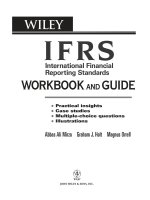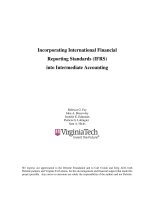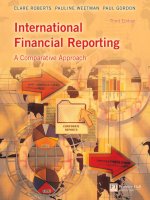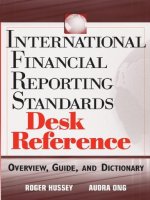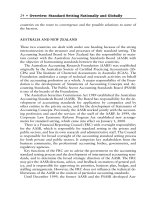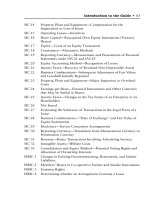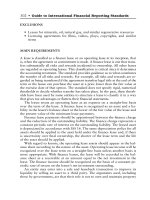international financial reporting standards
Bạn đang xem bản rút gọn của tài liệu. Xem và tải ngay bản đầy đủ của tài liệu tại đây (9.79 MB, 376 trang )
Inside Front Cover
The complete guide to
International Financial
Reporting Standards
Including IAS and Interpretation
Ralph Tiffin
Published by Thorogood Publishing Ltd
10-12 Rivington Street
London EC2A 3DU
Telephone: 020 7749 4748
Fax: 020 7729 6110
Email:
Web: www.thorogoodpublishing.co.uk
© Ralph Tiffin 2010
All rights reserved. No part of this
publication may be reproduced, stored in a
retrieval system or transmitted in any form
or by any means, electronic, photocopying,
recording or otherwise, without the prior
permission of the publisher.
This book is sold subject to the condition
that it shall not, by way of trade or
otherwise, be lent, re-sold, hired out
or otherwise circulated without the
publisher’s prior consent in any form of
binding or cover other than in which it is
published and without a similar condition
including this condition being imposed
upon the subsequent purchaser.
No responsibility for loss occasioned to
any person acting or refraining from
action as a result of any material in this
publication can be accepted by the author
or publisher.
Material quoted directly from the IASB in
this document is © 2010 IFRS Foundation.
All rights reserved. No permission
granted to reproduce or distribute.
A CIP catalogue record for this book is
available from the British Library.
RB: ISBN 1 85418 690 6
978-185418 690 4
Designed and typeset by Driftdesign
Printed in the UK by Marston Digital
Special discounts for bulk quantities of
Thorogood books are available to
corporations, institutions, associations
and other organisations. For more
information contact Thorogood by
telephone on 020 7749 4748, by fax on
020 7729 6110, or e-mail us:
The author
Ralph Tiffin is a mechanical engineer who subsequently qualified as a
Chartered Accountant and became manager in one of the largest international firms of accountants. He is now managing partner of an
accountancy and consultancy practice. He has a wealth of experience
with companies of all sizes in the UK and overseas. Work typically
involves developing clients reporting and management systems along
with appropriate management training and developing project appraisal
processes and spreadsheets.
This book is an aid to understanding the purpose of IFRS’s, the
principal accounting and disclosure issues and problem areas. To
ensure proper and detailed application of the Standards it will be
necessary to refer to the Standards, authoritative supporting
pronouncements and possibly seek appropriate expert opinion.
T H E AU T H OR
3
Contents
The author
1
3
Introduction
11
The purpose of this text
11
Why do we need Accounting Standards?
12
Why do YOU need to understand Accounting Standards?
12
Where is IFRS today? Where is IFRS heading?
13
Layout and how to use the book
14
How to use the book
14
Barriers to understanding
15
Understanding financial statement and accounting practices
15
Order of chapters
16
Summary objectives and requirements of the Standards
19
The Framework, financial statements, accounting concepts
and policies
31
3
Presentation of financial statements – IAS 1
43
4
Accounting policies changes in accounting estimates
and errors – IAS 8
53
Events after the reporting period – IAS 10
59
2
5
C ON T EN T S
5
6
6
Related party disclosures – IAS 24
63
7
First-time adoption of IFRS – IFRS 1
69
8
Interim financial reporting – IAS 34
73
9
Revenue – IAS 18
79
10 The effects of changes in foreign exchange rates – IAS 21
85
11 Employee benefits – IAS 19
93
12 Share based payment – IFRS 2
103
13 Borrowing costs – IAS 23
109
14 Accounting for government grants – IAS 20
115
15 Income taxes/current tax/deferred tax – IAS 12
121
16 Non-current Assets Held for Sale and
Discontinued Operations – IFRS 5
131
17 Earnings per share – IAS 33
137
18 Property plant and equipment – IAS16
145
19 Investment property – IAS 40
155
20 Intangible Assets – IAS 38
161
21 Impairment of assets – IAS 36
173
22 Inventories/Stock – IAS 2
185
23 Construction contracts/Long term WIP – IAS 11
191
24 Leases – off balance sheet finance – IAS 17
199
25 Provisions, contingent liabilities and contingent assets – IAS 37
211
26 Statement of cash flows – (cash flow statements) – IAS 7
223
THE COMPLETE GUIDE TO INTERNATIONAL FINANCIAL R EP ORTING S TANDAR DS
27 Business combinations – IFRS 3
231
28 Consolidated and separate financial statements – IAS 27
241
29 Accounting for investments in associates – IAS 28
247
30 Financial reporting of interests in joint ventures – IAS 31
253
31 Operating segments – IFRS 8
261
32 Financial instruments – disclosure and presentation – IAS 32
267
33 Financial Instruments: recognition and measurement – IAS 39
273
34 Financial Instruments: disclosures – IFRS 7
289
35 Accounting and reporting by retirement benefit plans – IAS 26
295
36 Insurance contracts – IFRS 4
301
37 Exploration for and Evaluation of Mineral Resources – IFRS 6
311
38 Agriculture – IAS 41
319
39 Other financial reporting in hyper inflationary economies
– IAS 29
325
40 Summary of IFRIC’s
329
Introduction
329
IFRIC Interpretation 1 – Changes in Existing
Decommissioning, Restoration and Similar Liabilities
329
IFRIC Interpretation 2 – Members’ Shares in Co-operative
Entities and Similar Instruments
330
IFRIC Interpretation 4 – Determining whether an
Arrangement contains a Lease
330
IFRIC Interpretation 5 – Rights to Interests arising from
Decommissioning, Restoration and Environmental
Rehabilitation Funds
331
C ON T EN T S
7
IFRIC Interpretation 6 – Liabilities arising from Participating
in a Specific Market – Waste Electrical and Electronic
Equipment
332
IFRIC Interpretation 7 – Applying the Restatement Approach
under IAS 29 Financial Reporting in Hyperinflationary
Economies
332
IFRIC Interpretation 8 – Scope of IFRS 2
332
IFRIC Interpretation 9 – Reassessment of Embedded
Derivatives
333
IFRIC Interpretation 10 – Interim Financial Reporting
and Impairment
333
IFRIC Interpretation 11 – IFRS 2 – Group and Treasury
Share Transactions
334
IFRIC Interpretation 12 – Service Concession Arrangements
334
IFRIC Interpretation 13 – Customer Loyalty Programmes
335
IFRIC Interpretation 14 – IAS 19 – The Limit on a Defined
Benefit Asset, Minimum Funding Requirements and their
Interaction
336
IFRIC Interpretation 15 – Agreements for the Construction
of Real Estate
336
IFRIC Interpretation 16 – Hedges of a Net Investment in
a Foreign Operation
336
IFRIC Interpretation 17 – Distributions of Non-cash Assets
to Owners
337
The titles of earlier Standards Interpretation Committee
announcements
41 Basic financial statements and other issues
8
337
339
Section One: Financial statement components
339
If there are profits there must be cash
349
THE COMPLETE GUIDE TO INTERNATIONAL FINANCIAL R EP ORTING S TANDAR DS
Section Two: Accounting ratios
354
Section Three: Creative accounting
362
In summary
367
Financial instruments
371
C ON T EN T S
9
1
Introduction
Accounting, used in this context to mean the recording and presentation
of business events in traditional financial statements (the balance sheet,
profit & loss account or income statement), is believed by many to be an
exact science. For many accountants, rules (though not all are written
down), convention and practice mean that events will always be recorded
correctly and presented fairly.
However, several difficulties present themselves: there are genuine differences in opinion as to exactly how events should be recorded and
presented; there is also the possibility of distorting both the recording
and the presentation; and finally, there is the question of what transactions
and events should be included in each set of financial statements.
Therefore there is a fundamental need for the existence and application
of Accounting Standards. There is the need for consistency throughout
the business world, the prevention of misleading presentation and disclosure of events.
The purpose of this text
The purpose of this text is to explain the principles of extant International
Accounting Standards (IAS). These have been re-titled International
Financial Reporting Standards (IFRS) as new Standards are introduced
and collectively IAS’s and the more recent IFRS’s are known as IFRS’s.
1
I N T RODU C T I ON
11
The text is aimed at: anyone in business who has to interface with
published accounts and internal reports; or who is responsible for reports
that are affected by or lead to published accounts. As never before,
professional advisers, directors and executive officers from functions
other than finance are affected by the requirements of Accounting Standards. Accountants and students of accountancy will also find this text
useful as a summary of Accounting Standards, as it cuts through to
exactly what the Standards aim to achieve and thus what has to be
accounted for and disclosed.
Why do we need Accounting Standards?
There are different views on how to account for and report business transactions. These may be due to cultural or commercial reasons or because
of legislative or taxation laws. A prime aim of Accounting Standards is to
bring consistency of reporting within and between countries. Investors
and others using financial statements (for example, for investing or
benchmarking purposes) can then make decisions based on consistently
prepared data.
However, consistency is not the only reason why Accounting Standards
are needed. There can be poor or down right bad accounting. Poor
accounting may mean lack of exactness giving a wide range of values or
inadequate disclosure. Bad accounting could mean fraud.
Why do YOU need to understand Accounting Standards?
Owners, directors, managers and professional advisers, such as lawyers,
have a responsibility to understand how business activities are presented
in the financial statements – i.e. is the reality of what is going on in the
business being properly and fairly presented. To appreciate if this is the
case an understanding of the requirements is needed.
12
THE COMPLETE GUIDE TO INTERNATIONAL FINANCIAL R EP ORTING S TANDAR DS
Where is IFRS today? Where is IFRS heading?
IFRS is well (or maybe that should be fairly well!) established in the EU and
many other countries. China and India are well underway in establishing
the use of IFRS. The US has indicated that IFRS will become acceptable
from 2011 or 2014 (depending to whom you talk!). However, there are
difficulties and dissenters to further (or in some cases full) adoption and
proper consistent convergence of national standards to IFRS.
To many of the regulators, the standard setters and those of an economic,
theoretical, or academic persuasion the Framework on which the
standards are based and the thinking that emanates from this is the ‘true
way’ – just believe the framework’s thinking and all will be well.
It is easy to carp and criticise but would any of us like to devise and write
them?
The Standards are being revised and developed and there are will be
some shocks – further significant changes to practice are mooted, for
example, on the accounting for leases and for long-term contract work in
progress (construction contracts). For both of these topics some critics
maintain that overly theoretical or impractical approaches to accounting
are being suggested.
This may be the case but any new IFRS does go through a fairly lengthy
and open development process with ample opportunity for comment.
Some issues are ‘issues of the day’, real or perceived issues arising in
response to rogue accounting that most accountants would never
contemplate. Thus content and demands of the standards can sometimes
seem unbalanced.
Much accounting and disclosure will be redundant for straightforward
businesses. The Standards (particularly those concerned with financial
instruments) have to try to cover every eventuality arising from the
‘clever’ gamblers and other ‘smart’ business school alumni.
It is not the purpose of this text to rehearse the arguments for and
against IFRS as it is today. However, we all need to be aware of the issues
that prevent faster and more consistent adoption of IFRS and we all
MUST understand the IFRS’s already in existence.
1
I N T RODU C T I ON
13
Layout and how to use the book
Each chapter will contain the following sections:
A
Key Points
What the Standard is about
B
What is in the Standard
The list as set out in the actual Standard or Framework
C
Why Needed
A brief explanation in simple terms of why a standard is needed
D
Ideas – concepts
The accounting issues and any underlying concepts that have
to be addressed
E
Key Content of the Standard
The key content of the Standard – with explanation if needed
F
Significant differences in GAAP
The main differences, if any, between IFRS, US and UK GAAP
How to use the book
•
If you want to get a feel for what the Standards cover and issues
to be addressed read A from each chapter.
•
If you need to know more – scan section B and read C and D.
•
For a more detailed understanding read E.
•
If convergence with UK GAAP is an issue for you or you have
to deal with financial statements produced under US GAAP
read F.
•
To use IFRS in practice you will have to access the IASB
published documents – and possibly seek professional help.
14
THE COMPLETE GUIDE TO INTERNATIONAL FINANCIAL R EP ORTING S TANDAR DS
Barriers to understanding
Terminology
A barrier to understanding accounting is the differing terminology and
statement layouts commonly used. Whilst there has been some success
in, for example, Standardising EU financial statement terminology and
layouts (appropriately translated), there remains much diversity. Accounting Standards should drive further standardisation in the use of words
and statement layout but different practices will remain. This is due to
differences in custom, cultural differences or the sloppy use of English.
For example: in the UK we say stock, in the US and under IFRS it would
be inventory.
In this text the words from the Standards are used as far as possible, but
common UK terminology is also frequently used. Thus profit & loss
account is used as well as income statement; business or company, as
well as entity.
Thought was given to using only the IFRS ‘word’ but in practice readers
will need to contend with different terminology. The everyday words are
often synonymous but there may be subtleties in different word usage.
Lesson: If in doubt check exactly how a word is being used.
Understanding financial statement and
accounting practices
Further support can be found at the end of the book where there are
review chapters covering:
•
What balance sheets, profit and loss accounts (income or earnings
statements) and cash flow statements aim to convey. The effect
of the principal different national differences in components and
layouts is explained.
•
The use of financial statements as a basis or interpreting a
business by carrying out ratio analysis is also outlined.
1
I N T RODU C T I ON
15
•
An explanation of the need for and rationale behind accounting
for and disclosure of financial instruments.
•
Finally, the effect on analysis through distortions in accounting
method and layout is demonstrated by examples of ‘creative
accounting’ – although of course if accounting standards are
based on clear principles there should be little room for interpreting how they should be applied.
Order of chapters
The majority of Accounting Standards were issued and have often been
re-issued in response to an event – a significant lapse in proper accounting
and disclosure. Thus the chronological or numerical order of the
Standards follows little logic (in any event it is questionable as to whether
academics or practitioners could agree to a logical order). The history of
the development of individual Accounting Standards often illustrates
why Standards are needed.
The Standards are dealt with in the following groupings, the aim being
to make the study of the Accounting Standards more coherent. If a
particular Standard or issue has to be understood then the table below
or the contents list should lead the reader to the topic.
16
THE COMPLETE GUIDE TO INTERNATIONAL FINANCIAL R EP ORTING S TANDAR DS
IAS/IFRS
number
The Framework, financial statements,
accounting concepts and policies
IASB Framework
–
Presentation of financial statements and reporting
financial performance
1
Accounting policies changes in accounting estimates and errors
8
Disclosures (of significant information)
Events after the balance sheet date
10
Related party disclosures
24
First-time adoption of IFRS
IFRS 1
Interim financial reporting
34
Profit & Loss Account – Income Statement
Revenue
18
The effects of changes in foreign exchange rates
21
Employee benefits
19
Share based payment
IFRS 2
Borrowing costs
23
Accounting for government grants
20
Income taxes / current tax / deferred tax
12
Discontinued operations
IFRS 5
Earnings per share
33
Balance Sheet
Property plant and equipment
16
Investment property
40
Intangible Assets
38
Impairment of assets
36
1
I N T RODU C T I ON
17
Inventories / Stock
2
Construction contracts / Long term WIP
11
Leases – off balance sheet finance
17
Provisions, contingent liabilities and contingent assets
37
Statements of cash flows
Statements of cash flows
7
Financial Instruments
Financial instruments – disclosure and presentation
32
Financial Instruments: recognition and measurement
39
Financial Instruments: disclosures
IFRS 7
Accounting for groups and investments
Business combinations
IFRS 3
Consolidated and separate financial statements
27
Accounting for investments in associates
28
Financial reporting of interests in joint ventures
31
Operating Segments
IFRS 8
Specialised industries
Accounting and reporting by retirement benefit plans
26
Insurance contracts
IFRS 4
Exploration for and Evaluation of Mineral Resources
IFRS 6
Agriculture
41
Other
Financial reporting in hyper inflationary economies
International Financial Reporting Interpretations Committee
Issues covered by interpretations issued (IFRICS’s)
18
THE COMPLETE GUIDE TO INTERNATIONAL FINANCIAL R EP ORTING S TANDAR DS
29
Summary objectives and requirements
of the Standards
Financial statements, Accounting policies and other disclosure issues
IAS 1 – Presentation of financial statements
Financial statements should have standard minimum content and the
basis upon which the figures are prepared should be explained.
The Standard sets out the minimum contents of financial statements:
balance sheet, income statement, cash flow statement, significant accounting policies, statement of changes in equity and supporting notes where
appropriate.
The Standard reiterates the fundamental accounting concepts of going
concern and accruals and their place in the accounting framework.
IAS 8 – Accounting policies, changes in accounting estimates and errors
There needs to be clear criteria for selecting and changing accounting
policies, together with the accounting treatment and disclosure of changes
in accounting policies, changes in accounting estimates and corrections
of errors. The Standard is intended to enhance the relevance, reliability
and comparability of an entity’s financial statements.
Disclosures (of significant information)
IAS 10 – Events occurring after the balance sheet date
Events may affect a company after the year’s end but before accounts
are ‘signed off’. Events may not cause change to figures in the financial
statements, however, to ignore them may be misleading to users of the
financial statements.
The Standard requires that significant events after the balance sheet date
should be reported by way of note(s) to the accounts.
1
I N T RODU C T I ON
19
IAS 24 – Related party disclosures
Who really owns and controls the business? This is vital information if
all those involved with the business are to be treated fairly.
The Standard requires disclosure of who really owns and controls the
business (related parties) along with details of transactions and balances
between the business and these related parties.
IFRS 1 – First time application of IAS’s
Businesses adopting IFRS’s should comply with them. The Standard
requires an entity to use the same (IFRS compliant) accounting policies
in its opening IFRS balance sheet and throughout all periods presented
in its first IFRS financial statements.
IAS 34 – Interim financial reporting
Interim financial reports must contain a minimum amount of reliable
information.
The Standard requires that interim financial statements should contain
the same individual reports and use the same accounting policies as the
annual statutory accounts. It may be practical and acceptable to demand
less detail in some of the disclosures and notes.
The Standard requires the disclosure of material one-off items, including
the costs of discontinuing operations. Non-current (fixed) assets that are
to be sold should be disclosed separately in the balance sheet.
Profit & Loss Account – Income Statement
IAS 18 – Revenue
The primary issue in accounting for revenue is determining when to
recognise revenue – when sales have been irrevocably earned.
The Standard requires that revenue only be recognised when quantifiable
inflows (of cash) will definitely occur. The Standard identifies the circumstances by which these criteria will be met and, therefore, revenue can
20
THE COMPLETE GUIDE TO INTERNATIONAL FINANCIAL R EP ORTING S TANDAR DS
be recognised. It also provides practical guidance on the application of
the criteria.
IAS 21 – The effects of changes in foreign exchange rates
Currency gains and losses can be realised or unrealised, many different
rates could be used for translation purposes, and gains or losses could
be shown in different places in the accounts.
The Standard requires that transactions should be translated at the rate
ruling at the date of the transaction. Balance sheet figures should be
translated at the rate ruling at the balance sheet date. For non-monetary
assets and liabilities the historical rate should be used.
IAS 19 – Employee benefits
The cost of employee benefits to a business should be disclosed,
particularly the cost of pension liabilities.
The Standard requires disclosure of all significant classes of employee
benefits, but particularly pension contributions. The Standard requires
disclosure of contributions to both defined contribution and defined
benefit schemes. For defined benefit schemes the adequacy of funding
has to be calculated and any liability due to under-funding disclosed.
IFRS 2 – Shared Based Payment
Entities often grant shares or share options to employees or other
parties. Without calculation of the cost of the payment and full disclosure
of long-term effects such payments may appear ‘free’. Awarding shares
or share options means that a portion of the value of the company is
being given away.
The Standard requires that a value is put on the cost of awarding share
based payments and that the cost is recognised immediately in profit and
loss.
1
I N T RODU C T I ON
21
IAS 23 – Borrowing costs
Borrowing costs relate to funding businesses and should be charged
against income as incurred. However, fixed assets often require considerable funds to finance their construction. Borrowing or interest costs
may be considered a cost specifically incurred to bring the asset into
revenue earning condition – under strict conditions the costs may be
capitalised.
The Standard requires that borrowing costs should be capitalised
(included as a cost of the fixed asset) when they are directly attributable
to the acquisition, construction or production of a fixed asset.
IAS 20 – Accounting for government grants
Grants may be given to support day-to-day operations – revenue, or to
encourage investment in fixed assets – capital. The correct classification
is important.
The Standard requires the correct matching of grant credits either as
revenue items or capital items. Specifically, capital grants (for equipment
etc.) should be spread over the life of the asset and not taken as income.
IAS 12 – Income taxes/current tax/deferred tax
An explanation of the bases for tax charges or credits and where they
are recognised in the financial statements is needed. Provision should be
made for future tax liabilities that will arise on the reversal of timing
differences between accounts and tax charges.
The Standard requires an explanation of the relationship between tax
expense or income and accounting profit. It also requires an explanation
of changes in the applicable tax rate(s) compared with the previous
accounting period.
The Standard requires that a deferred tax liability should be recognised
for all taxable temporary differences and charged to the income statement.
A deferred tax asset should be recognised to the extent that it is probable
that taxable profit will be available in the future against which to recover
tax or reduce liability.
22
THE COMPLETE GUIDE TO INTERNATIONAL FINANCIAL R EP ORTING S TANDAR DS
IFRS 5 – Non-current assets held for sale and discontinued operations
Profits and losses should generally be taken to the income statement
with any large one-off items disclosed separately, particularly the effects
of discontinuing operations.
The Standard requires the disclosure of material one-off items, including
the costs of discontinuing operations. Non-current (fixed) assets that are
to be sold should be disclosed separately in the balance sheet. Also the
reporting of errors or alterations to the figures due to changes in accounting
policies should be disclosed.
IAS 33 – Earnings per share
An earnings per share ratio is considered an important ratio. If there
was no clear definition then this ratio could be misrepresented.
This Standard prescribes the basis for calculating and presenting earnings
and other amounts per share in the financial statements of publicly
quoted entities.
Balance Sheet
IAS 16 – Property plant and equipment
Tangible fixed assets are a major part of capital employed for the many
businesses. They should be carried at cost, or if revalued then this should
be done so on a consistent basis.
The Standard codifies much of existing accounting practice. Assets may
be carried at cost or revalued. Fixed assets (except land) should be depreciated over reasonable periods.
IAS 40 – Investment property
Investment properties are held for gain, not consumption. It is inappropriate
to depreciate them, but they should be revalued to up-to-date fair value.
The Standard requires that investment properties should not be depreciated
but shown at fair value.
1
I N T RODU C T I ON
23
